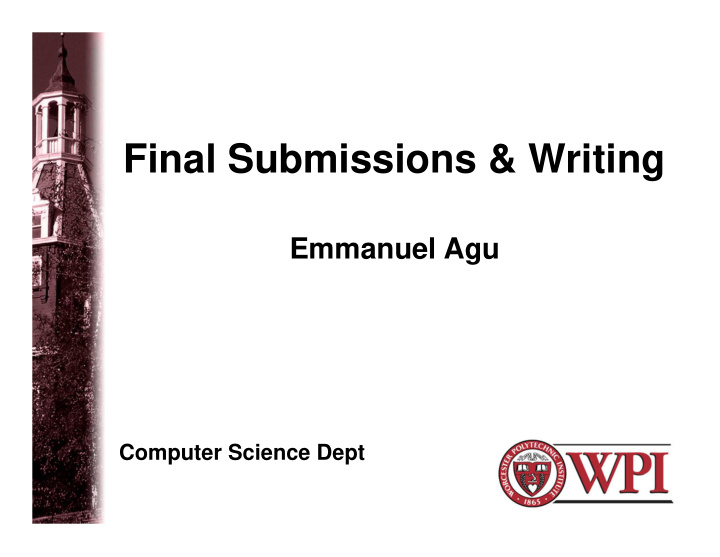



Final Submissions & Writing Emmanuel Agu Computer Science Dept
Final Submissions • Due April 26, class time. Each group – 15-minute talk – Paper formatted like ones we read. 10-page limit, two column – All source code and documentation for your project 2 Worcester Polytechnic Institute
The Paper • Abstract • Introduction: Motivate, summarize, preview • Related Work: shoulders of giants • Methodology/Design • Implementation • Experiments/Results • Conclusion • Future Work: Future work is earned 3 Worcester Polytechnic Institute
1: Tell me a story • what is “elevator pitch” of your story? elevator pitch = summary that is short enough to give during an elevator ride Story not what you did, but what you show, new ideas, new insights why interesting, important? why is story interesting to others? Big takeaways, hot topic, unexpected results? Know your story!
2. Write top down • Human beings think top down! • state broad themes/ideas first, then detail – Examples? – Intro summarizes/previews paper sections – First 2 sentences of paragraph summarizes entire paragraph. Rest of para is details
3 Introduction: crucial, formulaic • Reader not excited by intro? loses interest • Recipe: – para. 1: motivation: broadly, what is problem area, why important? – para. 2: narrow down: what is problem you specifically consider – para. 3: “In the paper, we ….”: most crucial paragraph, tell your elevator pitch – para. 4: how different/better/relates to other work – para. 5: “The remainder of this paper is structured as follows”
4. Master organized writing • paragraph = ordered, related sentences • lead sentence – sets context for paragraph – might tie to previous paragraph • sentences in paragraph should have logical narrative flow
5. Put yourself in reader’s shoes • less is more: take the time to write less • readers shouldn’t have to work – won’t “dig” to get story, understand context, results – Embed signposts saying where ‘story” is going, where we are • good: “e.g., Having seen that … let us next develop a model for …. Let Z be ….” • bad: “Let Z be” • write for reader, not for yourself – what does reader know/not know, want/not want?
5. Put yourself in reader’s shoes • page upon page of dense text is no fun to read – avoid tiny fonts, small margins – create openess with white space: figures, lists • enough context/information for reader – no one same background as you – no one can read your mind – all terms/notation defined?
6. No one (not even your mother) is as interested in this topic as you • you better be (or appear) interested • Don’t force feed the fish (too much stuff) • don’t overload reader with 40 graphs: – think about main points to convey with graphs – can’t graph all variables • don’t overload reader with pages of equations – put long derivations/proofs in appendix, – provide sketch in body of paper
7. State the results carefully • clearly state assumptions (see overstate/understate your results) • Reproducibility: experiment/simulation description: enough info to nearly recreate experiment/description • simulation/measurements: – statistical properties of your results (e.g., confidence intervals) • are results presented representative? – or just a corner case that makes the point you want to make
8. Don’t overstate/understate your results • overstatement mistake: – “We show that X is prevalent in the Internet” – “We show that X is better than Y” when only actually shown for one/small/limited cases • understatement mistake: fail to consider broader implications of your work – if your result is small, interest will be small – “rock the world”
9. Study the art of writing • writing well gives you an “unfair advantage” • writing well matters in getting your work published in top venues • highly recommended: – The Elements of Style, W. Strunk, E.B. White, Macmillan Publishing, 1979 – Writing for Computer Science: The Art of Effective Communication, Justin Sobel, Springer 1997. • who do you think are the best writers in your area: study their style
10. Good writing takes times • give yourself time to reflect, write, review, refine • give others a chance to review, give feedbac k – get a reader’s point of view – find a good writer/editor to critique your writing • starting a paper three days before the deadline, while results are still being generated, is a non-starter
References • Jim Kurose, 10 tips for Writing papers, CoNEXt Students Workshop 2006 15 Worcester Polytechnic Institute
Recommend
More recommend